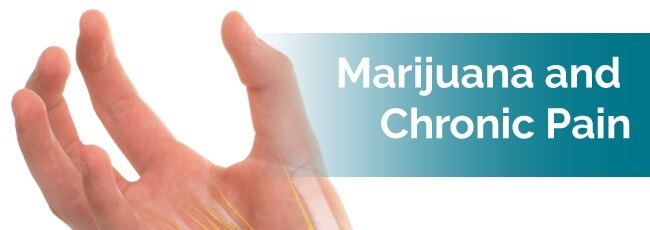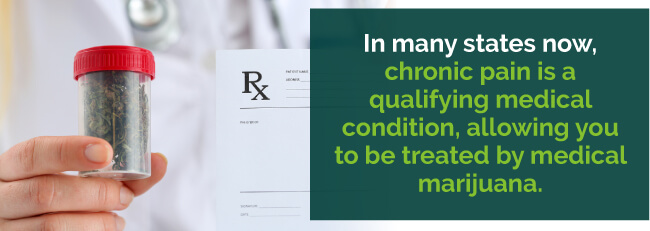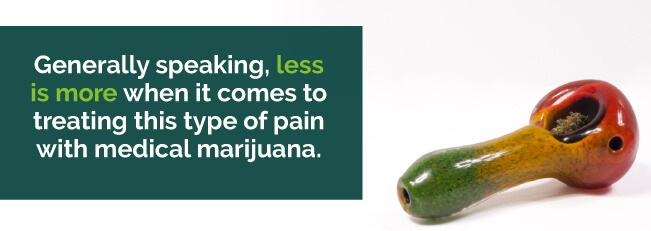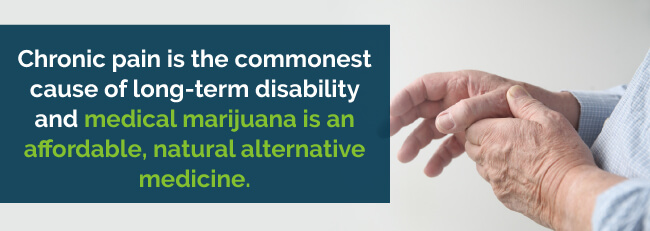
For patients with chronic pain-related ailments, medical marijuana could mean relief from persistent, life-altering pain. Whether patients are suffering from chronic pain ailments like fibromyalgia or have pain related to the treatment of another illness like cancer, medicinal cannabis can help improve patients’ quality of life by easing common causes of pain like inflammation. Learn about different types of chronic pain, how pain affects patients’ quality of life, and how medical marijuana is becoming a more prominent treatment for pain across the nation.
Years worth of anecdotal evidence points to the efficacy of marijuana to treat chronic pain conditions. Nowadays, medical and scientific communities are catching up with what many marijuana advocates have known for years.
So, what do the studies say? According to a Harvard-led review of 28 studies of cannabinoids to treat medical and pain issues published in the Journal of the American Medical Association, the use of marijuana for chronic pain is supported by quality evidence.
Of the studies reviewed, all six generalized chronic pain studies found a substantial improvement through using cannabis.
Furthermore, a study from the University of Michigan from March 2016 and published in the Journal of Pain showed that marijuana:
Your body creates its own cannabis-like chemicals that affect various processes like inflammation and pain. It’s thought that cannabis works well to treat chronic discomfort due to these natural cannabinoid receptors we all have within our bodies, although more research needs to be done to ascertain exactly how marijuana works to relieve pain
Find A Doctor Find A Dispensary
It can be difficult for you to deal with chronic pain without help. Medical marijuana and pain conditions are closely related regarding alleviating symptoms you may have been suffering from for a protracted time. Medical pot may offer you substantial relief if you suffer from any of the following:

In many states now, chronic pain is a qualifying medical condition, allowing you to be treated by medical marijuana. One of the latest states to approve medical marijuana for the treatment of chronic pain is New York. Effective March 22, 2017, chronic pain is a qualifying medical condition for the NY State Medical Marijuana Program approved by the Health Commissioner, Dr. Howard A. Zucker.

States that have specifically qualified chronic, severe, intractable or other types of pain as a qualifying medical condition for medical marijuana treatment include:
Keep in mind that state laws are continuously being passed that may expand this list. You can be added to our medical marijuana waitlist if your state has yet to qualify medical cannabis for pain.
While marijuana is generally praised for its safe and therapeutic properties, many users enjoy the fact that cannabis offers a treatment plan with many different methods of intake, too.
Depending on the state laws that define your area, you may not be able to access marijuana in all forms — even in states with a legal medical marijuana program. Be sure to verify the intake methods permitted in your region before pursuing a specific medical marijuana plan.
Many patients with chronic or severe pain enjoy smoking or vaporizing their cannabis supply when possible. Since these intake methods provide a more rapid effect in the body, they offer a quick way to experience relief. If the ability to minimize discomfort rapidly is vital to your treatment, consider discussing this intake method with your physician in greater depth.
Cannabis can also be ingested via capsules, tablets, tinctures and edibles. For localized pain treatment, consider using a topical, such as an ointment or cream, instead. You’ll experience targeted pain relief in the specific portion of your body where pain is occurring.
Many patients find it beneficial to incorporate multiple intake methods into their wellness plan. For more information about the cannabis supply and methods that are best suited for your needs, discuss your options with a certified marijuana doctor.
Whether you use edible forms of medical cannabis for pain, roll it into a joint or use a vaporizer, there are many different strains of the plant that can substantially reduce discomfort. Perhaps you feel better when you smoke the drug, whereas someone else may find that taking low-dose edibles works for them.
Of course, the chemical composition of the strain you choose as well as your method of ingestion may affect your painkilling outcome. Keep in mind that it’s likely you might need to take a trial and error approach before you hit on the right strain and dosage for you.
Generally speaking, less is more when it comes to treating this type of pain. Many people find that sativa strains higher in THC — the primary psychoactive substance that gives you a “high” — work better for them than hybrid or indica strains. These also work most effectively in doses that are low to moderate and can potentially make your pain worse in higher doses.

No matter how you plan to ingest medical cannabis, there are various strains that can help reduce your discomfort. These include:
Although it can be difficult to find, ACDC contains high levels of the cannabinoids CBD and THC. Advocates of this strain indicate that the benefits are numerous.
A potent general pain reliever, Afghan Kush is almost 100 percent indica. Its effects are felt mostly physically which is why it works so well regarding pain relief. Afghan Kush contains anti-inflammatory and painkilling terpenes.
This strain also contains caryophyllene, which is known to work against cancer. Therefore, if your pain is cancer-related, this could offer you relief. Other useful strains high in caryophyllene include Super Sour Diesel, Maui Waui and Hash Plant.
Blue Dream is a hybrid sativa that was first grown in California. It provides not only relaxation throughout the entire body, but many users also find it to be invigorating. This strain produces a mellow euphoria that yields a calming effect and also has an aroma similar to berries. Since it doesn’t result in the sedative effects of other strains, Blue Dream is well-suited for daytime use.
Another Californian type, Granddaddy Purple has been in existence for approximately 15 years. This strain can be potent, so don’t use it if you plan to go out during the day or the evening. Patients use Granddaddy Purple to relieve symptoms from pain, muscle spasms, stress, insomnia and more.
This is another hybrid with a sweet aroma that’s very easy to spot, thanks to its orange hairs and purple leaves. This strain is well-known for producing a feeling of relaxation throughout the body and is popular among people who suffer from not only severe pain but also nausea and loss of appetite. The Girl Scout Cookies strain is best taken in small doses until you’re certain of how much you can handle at one time.
A well-known strain for easing nerve pain, Jack Herer, named after the author and activist, is high in sativa. Filled with natural painkillers, Jack Herer contains pinene that has anti-tumor properties.
A half-and-half cross between a pure indica and a pure sativa, this is a well-balanced strain that makes you feel uplifted while tackling your pain. White Widow also contains linalool, an anti-inflammatory and pain reliever that’s also found in lavender.
Always speak to your doctor about which medical marijuana strain is anticipated to work best for your type of pain.
It’s imperative that you start off with the lowest dose possible when you’re beginning to take medical pot. You’ll soon find out via a trial and error process what works best for you.
If you do have any side effects of ingesting medical marijuana, they won’t last long and may include:
Medical marijuana affects everyone differently, but overall the marijuana side effects are more manageable and milder than those that come with traditional medicines like opioids.
Medical marijuana is an affordable, natural alternative that lacks the side effects found in the medicines traditionally used to treat chronic pain. In 1975, researchers found that THC was an effective pain reliever for cancer patients and found that it lacked the significant or toxic side effects found in traditional medicines. Since then, countless other studies have shown that marijuana safely and effectively treats various types of chronic pain with little to no side effects or risk of dependency.
Americans from all walks of life and social classes have been badly impacted by the current opioid epidemic. According to one study, opioid prescriptions have risen 400 percent since 1999. On a daily basis as many as 40 people have fatal reactions to prescription narcotic overdoses. Many chronic pain sufferers are looking for safer alternatives.
The legalization of medical marijuana for chronic pain in many states has resulted in a pain-management revolution for many individuals. Using cannabis to treat pain means many chronic pain sufferers can significantly reduce their reliance on opioids.
In August 2017, the National Institute of Health (NIH) awarded a $3.8 million research grant to Montefiore Health System and Albert Einstein College of Medicine to study if medical marijuana can help reduce the use of opioids to treat chronic pain. The grant will help the college understand how medical marijuana helps safely treat patients dealing with debilitating pain and suffering.
While life-altering, medical professionals are now equipped with the knowledge — and medication — necessary to treat chronic pain issues in patients. But before you decide to explore cannabis or select a treatment plan, you should know more about the symptoms and various forms that define chronic pain first. Below, we’ll explore this condition in greater depth so that you can pursue your wellness plan with an informed mindset.
Chronic pain is a state in which pain persists beyond the usual course of an acute disease or healing of an injury, or that may or may not be associated with an acute or chronic pathologic process that causes continuous or intermittent pain over months or years. Research has shown that medical cannabis for pain can be an effective method of treatment that is far safer than many other options.
Chronic pain is an often-incapacitating condition that affects every aspect of your life. It can make the simplest of activities, such as buttoning your shirt or tying your shoes, a struggle. Over time, the condition takes its toll, and you can find yourself becoming down and depressed due to your constant struggle with your pain. Unlike temporary pain which often resolves within days or weeks, chronic pain is often much more impactful due to its long-lasting nature.
Unlike other health complications which may afflict certain portions of the body, chronic pain can be widespread and is likely to influence patients differently.
However, there are three primary forms of chronic pain that impact patients the most. Common types of chronic pain include the following:
If you sustain an injury, an acute and sudden pain is a normal physical sensation triggered within your nervous system to alert you that something is wrong. Contrastingly, chronic pain is persistent. Perhaps there was an initial illness or injury that brought on your chronic pain. You may have suffered from a severe infection or injury, or there could be an ongoing cause of this pain, such as cancer, fibromyalgia or arthritis. Alternatively, there may be no definitive cause.
Pain signals may be firing within your nervous system for weeks, months and even years, and older people are often afflicted. Because the ability to withstand chronic pain is typically subjective and personal, it can be impossible to measure. Your doctor must rely on your words and a description of the pain, often using a pain scale, to evaluate you.
A condition that has not always been entirely understood by the medical community, chronic pain can be difficult to treat by conventional means. There used to be a time where doctors believed the excruciating condition was always a side effect of an underlying disease or injury. Because of this, the medical profession focused solely on pinpointing and then treating the cause of this discomfort, believing this would then correct the chronic pain condition.
Often, no underlying cause could be found. This is referred to as idiopathic pain — also called pain of unknown origin — and patients were often told that their conditions were psychosomatic, or in their heads. People who were feeling real and long-term pain were frequently told there were few or no treatments available.
Chronic pain is a real problem for Americans today.
Information from a National Institutes of Health report shows:

According to information from the National Center for Complementary and Integrative Health in 2012:
Considering these statistics, it’s clear that chronic pain is endemic in modern American life. Unfortunately, there are still some doctors today who seem to ascribe to this archaic way of thinking. This is why so many people are taking their health into their own hands and are turning to alternative methods of pain relief, particularly marijuana.
The most immediate symptoms of chronic pain include aching, discomfort and general feelings of pain. The persistent pain that patients experience can greatly interfere with their daily sense of wellbeing.
When you’re in constant pain for a length of time, it can have a significantly detrimental effect on your emotional and psychological health, too. You may feel cut off from your friends and family as you’re no longer able to take part in activities you once enjoyed. You may always be exhausted as sleep is difficult due to physical discomfort. You may also be unable to hold down a job and consequently find you can no longer afford your usual standard of living.
The main goal of conventional chronic pain treatment is to improve your physical function and reduce the pain you’re suffering so you can return to your usual daily activities. There are several treatments your doctor may prescribe. These include:
Many of these treatments, such as painkilling medications, can have unpleasant side effects. In fact, commonly prescribed opioids are potentially toxic and are highly addictive. Additionally, long-term use of conventional pain relievers, like NSAIDs, acetaminophen and opioids, is associated with many negative impacts on your health, such as hepatotoxicity, heart attacks, erectile dysfunction and strokes.
Chronic pain can be so debilitating that sufferers often turn to powerful opioid narcotics to find relief. These drugs are not only addictive, but they’re also notoriously toxic. Nearly 30,000 people died from opioid overdoses in 2014 alone.
If you suffer from pain, medical marijuana could significantly alleviate your symptoms and improve your quality of life. Research has shown that medical cannabis for chronic pain can be an effective method of treatment that is far safer than many other options.
Medical cannabis for chronic pain has been shown to be an extremely effective treatment and much safer than opioids. Patients suffering from pain related to the nervous system have found particularly strong improvement in symptoms, whether they smoke cannabis, eat it or use it in an oral spray. With an alarmingly high number of people dying due to an epidemic of opioid overdoses, cannabis is becoming a much more popular alternative for many who suffer from pain on a daily basis.
In many instances, cannabis has been shown to not only decrease the side effects that result from taking opioids and other medications, but also improve the quality of life for many patients. It’s very important to note, however, that you should never change your treatment regimen unless you are closely supervised by a physician. Drastic changes could have potentially damaging effects. Have a long, detailed discussion with your doctor to make sure he or she agrees that you would benefit from using medical cannabis for pain.
Remember that you can only legally obtain cannabis for your chronic pain if you have a card from a medical marijuana doctor. That’s why it’s important for you to search for a medical marijuana doctor in your state.
There is increasing evidence to support medical marijuana as a very effective treatment for chronic pain conditions. With more research being carried out into how exactly pot works in relation to thwarting pain, the drug could well turn out to be one of the most pivotal treatments of our modern times.
When you’re new to the world of medical marijuana for pain, you may be understandably confused as to what strains work best for your medical condition. Don’t be afraid to ask what you may think are “stupid” questions when you speak to a medical marijuana doctor or dispensary staff. That’s what they’re there for.
To learn more about using medical marijuana to relieve your pain, book an appointment through MarijuanaDoctors.com today. Or, if you’re worried about the effects that conventional pain-killing medications are having on your health, take that next step and search for a marijuana dispensary or medical marijuana doctor in your state today. Let us help improve your quality of life!
Find A Doctor Find A Dispensary